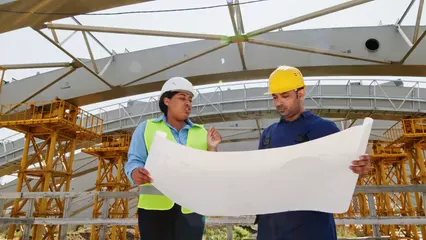
Why Would a Contractor Use Critical Path Activities in Construction
Introduction
Have you ever wondered how construction projects stay on track? The Critical Path Method (CPM) plays a vital role in this. CPM is a project management technique that helps contractors manage time and resources effectively. By pinpointing essential tasks, it ensures projects avoid delays and cost overruns. This article will explain why contractors utilize critical path activities in their projects.
To dive deeper into the intricacies of CPM, consider picking up a copy of Critical Path Method for Construction: A Comprehensive Guide Book. This book is a treasure trove of information that can help you grasp the details of CPM and how it applies to your projects.

Summary and Overview
The Critical Path Method (CPM) is crucial in construction project management. It defines the sequence of critical tasks that determine the project’s minimum duration. Understanding critical path activities directly influences project success. When contractors focus on these tasks, they can streamline scheduling and allocate resources effectively. The overall benefits of utilizing CPM in construction include timely completion and budget management.
What is the Critical Path Method (CPM)?
Definition and History
The Critical Path Method (CPM) is a scheduling technique developed in the late 1950s. Initially created for complex projects, it has become a fundamental tool in construction. By breaking down tasks and establishing their relationships, CPM helps ensure timely project delivery.
Key Components
Understanding the key components of CPM is essential:
- Critical Path: This is the longest sequence of dependent activities, dictating the shortest time to complete a project. Any delay here impacts the overall timeline.
- Tasks/Activities: Each project is divided into individual tasks, each with a specific duration.
- Dependencies: Tasks often depend on one another. Recognizing these relationships is crucial for effective scheduling.
- Float/Slack: This term refers to the time a task can be delayed without affecting the project completion date. Critical path tasks have zero float.
Statistics show that around 75% of construction projects utilize CPM to optimize scheduling. This widespread adoption highlights its importance in the industry. With the right tools, such as CPM software, contractors can enhance project management and ensure timely completion. For those looking to gain a comprehensive understanding of these tools, the Microsoft Project 2019: The Missing Manual is a must-read!

Why is Critical Path Important in Construction?
Importance of Timely Completion
Timely completion is crucial in construction. Critical path activities help contractors meet project deadlines. When a contractor identifies these tasks, they can prioritize them effectively. This focus ensures that essential activities are completed on schedule. Delays in critical path tasks can cascade, impacting the entire project timeline. By managing these activities diligently, contractors can maintain progress and avoid unnecessary delays. Ultimately, this leads to satisfied clients and successful project delivery.
Cost Implications
Delays in critical path activities can lead to significant cost overruns. According to research, around 30% of construction projects experience budget overruns due to delays. When critical tasks are postponed, additional expenses accrue. These may include extended labor costs, equipment rentals, and potential penalties. Effective management of critical path activities minimizes these financial risks. By keeping projects on track, contractors can ensure better cost control and budget adherence. This financial discipline enhances overall project profitability.

Resource Management
The Critical Path Method (CPM) plays a vital role in optimizing resource allocation. By identifying critical tasks, contractors can allocate resources more efficiently. This approach ensures that labor, materials, and equipment are available when needed. It prevents resource wastage and enhances productivity. For example, if a task requires specific tools, knowing its criticality allows for timely procurement. Speaking of tools, a Construction Worker Tool Belt can be a game-changer for keeping your tools organized and accessible!
For better implementation of CPM in your construction projects, consider reaching out to a project management consultant. They can provide tailored strategies to enhance your project outcomes.

Benefits of Using Critical Path Activities
Improved Planning and Scheduling
Using the Critical Path Method (CPM) significantly enhances project planning. By pinpointing critical activities, contractors can improve scheduling accuracy. This method allows for a clear visualization of task dependencies. When you know which tasks are essential, you can better allocate time and resources.
A study showed that projects utilizing CPM achieve a 20% higher success rate. Why? Because they focus on the most critical tasks. This focus helps avoid bottlenecks and keeps projects on track. It means fewer surprises and a smoother workflow.

Enhanced Communication
Effective communication is vital in construction. CPM fosters better communication among all stakeholders. When everyone understands the critical path, it creates a common language. This clarity helps teams collaborate more efficiently.
Imagine a project manager, subcontractors, and suppliers all on the same page. They can quickly share updates and address issues. This transparency reduces misunderstandings and aligns everyone toward common goals. To help with this, consider utilizing a Project Management Planner and Journal to keep your thoughts organized!

Risk Management
Risk management is another significant benefit of using CPM. It allows for the proactive identification of potential delays. By analyzing the critical path, contractors can foresee where issues might arise.
For instance, if a task depends on weather conditions, managers can plan contingencies. This foresight minimizes disruptions and enhances project resilience. As a result, projects can adapt to unexpected challenges without derailing timelines. To help mitigate risks, ensure you have a Construction Safety Management and Engineering Book on hand!

Increased Accountability
Defining critical activities clarifies responsibilities for team members. Each person knows their role in the project’s success. This structure fosters individual accountability.
When tasks are clearly assigned, it’s easier to track progress. If delays occur, it’s straightforward to identify the cause. This accountability improves overall project efficiency. Ultimately, it leads to a more disciplined approach to project management. To further enhance your project management skills, you might want to check out The 7 Habits of Highly Effective People Book. This classic can provide you with valuable insights into personal and professional effectiveness.

Incorporating CPM practices can transform your construction projects. Embrace this method, and watch your projects thrive with improved planning, communication, risk management, and accountability.
Best Practices for Managing Critical Path Activities
Regular Monitoring and Adjustment
Ongoing assessment is key in managing critical path activities. By regularly reviewing the project timeline, you can spot potential delays early. This proactive approach allows you to make adjustments before issues escalate. For example, if a task is falling behind, reallocating resources can help get it back on track. Consider using project monitoring tools to aid in this process. These tools often provide real-time updates, enabling you to respond quickly to changes.

Utilize Technology
In today’s fast-paced construction environment, technology is vital for effective CPM management. Software tools like Primavera P6 Professional Project Management and Microsoft Project can streamline scheduling and resource allocation. These applications offer features such as Gantt charts, which visually represent task dependencies. Data from a recent survey shows that 78% of construction firms now use project management software. This trend highlights the importance of technology in enhancing project efficiency and communication.

Engage Stakeholders
Effective stakeholder communication is crucial for managing the critical path. Keeping everyone informed fosters collaboration and aligns goals. Regular updates and meetings help address concerns promptly. Engaging stakeholders ensures that all parties understand their roles within the project timeline. This involvement creates a sense of ownership and accountability, ultimately leading to smoother project execution.

By implementing these best practices, you can optimize your project management efforts. For more insights and updates on project management best practices, consider subscribing to our newsletter. And don’t forget, a good Gantt Chart Template for Project Management can help you visualize your tasks effectively!

Conclusion
Utilizing critical path activities in construction is essential for timely and budget-friendly project completion. By focusing on critical tasks, contractors can enhance planning, communication, and risk management. Adopting CPM practices will help you achieve better outcomes in your future projects. Embrace these strategies and watch your projects thrive!
FAQs
What is a critical path in construction?
The critical path is the longest sequence of dependent activities in a construction project. It determines the shortest time needed to complete the project. If any critical task is delayed, the entire project timeline is affected. Understanding the critical path helps contractors prioritize essential activities and manage their schedules effectively.
How can I identify critical path activities?
To identify critical path activities, start by listing all project tasks. Next, determine task dependencies and how they are connected. Then, estimate the duration for each task. Use a network diagram to visualize tasks and their relationships. Analyzing this diagram allows you to pinpoint which activities are critical to the project’s timeline.
Can a project have multiple critical paths?
Yes, a project can have multiple critical paths. This occurs when there are several sequences of tasks that require the same amount of time to complete. Each critical path can impact the overall project duration. Understanding these paths is vital for effective project scheduling and management.
Why is float important in project management?
Float, or slack, refers to the amount of time a task can be delayed without affecting the project’s completion date. It allows for flexibility in scheduling. Effective management of float can help project managers handle unexpected delays and resource constraints while maintaining the overall timeline.
What software can help with CPM?
Several software options can assist with critical path management (CPM). Popular choices include Microsoft Project, Primavera P6, and GanttPRO. These tools provide features for scheduling, resource allocation, and progress tracking. Utilizing project management software can greatly enhance your ability to manage critical path activities effectively.
Please let us know what you think about our content by leaving a comment down below!
Thank you for reading till here 🙂
Understanding the significance of critical path activities can greatly enhance your construction management skills. why would a contractor use critical path activities in construction
All images from Pexels




